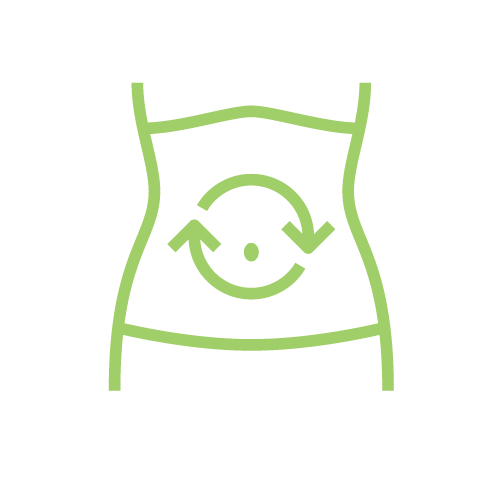
Intestinal and Abdominal Surgery
Abdominal surgery refers to any surgery performed in the abdominal region. The small and large intestines take up the largest amount of space in the abdominal cavity. Surgeries involving the intestines is broadly referred to as intestinal surgery. There are two types of intestinal surgery – conventional open surgery and minimally invasive laparoscopic/robotic surgery.
In conventional open surgery, a larger incision (cut) is made in the abdomen for the surgeon to directly view the abdominal cavity and make repairs. In laparoscopic/robotic surgery, a few smaller incisions are made and repairs are made with the assistance of a laparoscope – a small instrument with a tiny camera and light at the end.
A tube (trocar) is inserted through which the surgeon inserts the laparoscope, as well as two to three additional trocars. These trocars allow the surgeon to insert small surgical tools. The laparoscope allows the surgeon to see inside the abdominal cavity without opening up a large incision.
Compared to open surgery, laparoscopic/robotic surgery usually offers the following advantages:
- Less pain
- Lower rate of complications
- Shorter hospital stay
- Shorter recovery time
Parts of the Lower Gastrointestinal Tract
A general understanding of the gastrointestinal tract is helpful when an abdominal surgery is needed. The digestive system is divided into the upper digestive tract and the lower digestive tract, which sits in the lower abdominal cavity. The lower gastrointestinal (GI) tract consists of the part of the small intestines and the large intestine. There are also accessory glands that open into the upper GI, including the liver and pancreas.
Types of Intestinal Surgery
At Advanced Laparoscopic Associates, we perform the following surgical procedures to treat hepatobiliary conditions:
Use the squares below to navigate the content
Lysis of Adhesions
Lysis of adhesions is a surgery to disconnect bands of tissue (adhesions) that form between organs, connecting the organs to each other. These bands are often caused by scar tissue formed after a previous abdominal surgery. Adhesions can cause severe pain and impede the proper functioning of the organs involved.
Indications
The largest risk factor and predictive factor of adhesion formation is a history of previous abdominal surgery. Most intestinal obstructions occur after lower abdominopelvic surgeries such as hysterectomy, colectomy and appendectomy. The most common complications caused by adhesions are small bowel obstruction and chronic pain. In less complicated cases of small bowel obstruction, a conservative, nonsurgical treatment may be employed as a first treatment measure.
If conservative treatment fails, surgery may be required. Surgeries include both conventional open or minimally invasive approaches. Minimally invasive surgery has become more popular for lysis of adhesions and the treatment of a small bowel obstruction.
Procedure
Lysis of adhesions may be done using minimally invasive laparoscopy, using only a few small incisions in the abdomen. Open surgery is another option, which employs a much larger incision. Both procedures are performed under general anesthesia.
In laparoscopy, two to four small cuts are made in the abdomen. A laparoscope with a camera and light is inserted, as well as two to three additional trocars. These trocars allow the surgeon to insert small surgical tools into the abdomen if needed. The camera allows the surgeon to see inside the abdomen. The abdomen is filled with carbon dioxide gas to make room for the surgeon to work easily within the cavity.
If open surgery is performed, the surgeon makes a large incision in the abdomen and no laparoscope is used. In both types of surgery, the surgeon cuts away the adhesions and possibly part of the small or large intestine. The incisions are then closed.
Recovery
After surgery, feelings of weakness, nausea and being tired are expected. Some abdominal and incision pain is common and should steadily improve in the next few weeks after surgery. Normal activities may be resumed after two to four weeks. Bowel movements may not be regular for several weeks and some blood in the stool may be present. Pain medication may be prescribed as needed.
Small Bowel Resection/Bypass
The small bowel is another name for the small intestine. Small bowel resection is surgery to remove part or all of the small bowel when part of the small bowel is blocked or diseased.
Indications
Small bowel resection/small bowel bypass may be recommended for the following:
- Bleeding in the intestine
- Cancer
- Crohn’s disease
- Infection
- Injury to the intestine
- Intestinal obstruction (intestinal blockage) due to scar tissue or deformities
- Precancerous polyps
- Ulcers due to inflammation of the small intestine (regional ileitis or regional enteritis)
- Volvulus (twisted bowel) causing obstruction
Procedure
The surgery can be performed with minimally invasive laparoscopy or with conventional open surgery and takes approximately one to four hours. In laparoscopic surgery, the surgeon makes three to five small incisions in the lower abdomen. A laparoscope with a camera is inserted through one of the incisions. A larger incision of two to three inches may also be made if the surgeon needs to put a hand inside the abdomen to feel the intestine or remove the diseased portion. As with lysis of adhesions, the abdominal cavity is filled with gas. The affected part of the small intestine is removed. Open surgery requires an incision of six to eight inches.
In both surgeries, if there is healthy small intestine left, the ends are attached by sutures or staples. This procedure is called an anastomosis and most patients have this done. If the intestines is not healthy enough to connect, the surgeon creates an opening called a stoma through the skin of the abdomen. Any opening in the body is a stoma, whether natural (anus) or artificial, through surgery. An ileostomy is then performed, which connects the last part of the small intestine (ileum) to the abdominal wall. Fecal waste will pass from the ileostomy through the stoma into a drainage bag outside the body. The ileostomy and stoma may be either temporary or permanent.
Recovery
The recovery outcome depends on the extent of the disease. Most patients will stay in the hospital for five to seven days. Complete recovery may take two months. Pain medication may be prescribed as needed.
A small tube will be inserted into the stomach and is used to remove the stomach contents so that the intestines can recover after surgery. Once the tube is removed, a light diet is started. Soon, feces will start to pass through the stoma into a lightweight bag.
Feces will usually be thin and watery. Instructions will be given on how to change the bag. Sutures are removed in five to six days. Diet is restricted for the first couple months, then may return to normal, though certain types of food should be avoided.
If the stoma is temporary, a subsequent operation is needed to reattach the bowel so feces pass through the anus. If the stoma is permanent, there will be no voluntary control over the passage of feces, which is also likely to be thin and watery. A stoma association support group is often recommended as they can advise patients regarding many concerns, such as clothing, body image and sexuality.
Colectomy/Large Bowel Resection
Colectomy is a surgery to remove all or part of the colon (large intestine). Colectomy surgery often requires additional procedures to reattach the remaining portions of the digestive system and permit fecal waste to leave the body, such as colon resection surgery.
Indications
Colectomy is performed to prevent and treat diseases and conditions that affect the colon, such as:
- Bowel obstruction
- Colon cancer
- Colonic inertia (rare motility disorder also known as slow-transit constipation), which affects the large intestine (colon) and results in the abnormal passage of stool, characterized by severe, constant constipation, abdominal distention and abdominal pain
- Crohn’s disease
- Ulcerative colitis
- Diverticulitis
- Preventive surgery for those at high risk of developing colon cancer due to multiple precancerous colon polyps or inherited genetic conditions that increase colon cancer risk
- Uncontrolled bleeding from the colon
- Volvulus (twisted bowel) causing obstruction
Procedure
The type of colectomy performed depends on the condition and surgeon’s expertise. The surgery can be performed with minimally invasive laparoscopy or with conventional open surgery. Though laparoscopic colectomy may reduce pain and recovery time after surgery, not all patients are a candidate for this procedure. There are multiple types of colectomy operations:
- Total colectomy removes the entire colon.
- Partial colectomy removes part of the colon; may also be called subtotal colectomy.
- Hemicolectomy removes the right or left portion of the colon.
- Proctocolectomy removes both the colon and rectum.
Once the colon has been repaired or removed, the surgeon will reconnect the digestive system to allow the body to remove waste. Options for this include:
- Rejoining the remaining portions of the colon (anastomosis) so feces will exit the body as before.
- Connecting the colon (colostomy) to an opening created in the abdomen (stoma), allowing waste to leave the body through the stoma into a colostomy bag. This may be temporary or permanent.
- Connecting the small intestine to the anus. If both the colon and the rectum are removed (proctocolectomy), a portion of the small intestine may be used to create a pouch that is attached to the anus (ileoanal anastomosis). This allows normal waste excretion through the anus, though patients usually have several watery bowel movements each day.
Improvements in colorectal surgery – robotic surgery
ALA also uses the most advanced technology available to optimize successful results, such as robotic-assisted surgery. Colorectal surgery has been revolutionized by the development of robotic surgery. With the application of robotic-assistance in these procedures the surgeon is offered enhanced precision. A specialized camera displays magnified and three dimensional visualizations of the intended area of surgery. The surgeon sits at a console and directs the robotic arms. These arms hold the necessary instruments and use their multi-dimensional wrists to smoothly maneuver into areas that typically may not even be laparoscopically operated on (requiring open surgery).
Robotic colorectal surgery was developed to overcome limitations of laparoscopic surgery. This means that patients with colon and rectal conditions of higher complexity are now able to experience minimally invasive surgery that laparoscopic procedures have not always been able to address. Additionally, with the use of robotic colorectal surgery as opposed to more invasive surgeries, the patient may see fewer days of hospitalization and in-home recovery due to the minimization of trauma to the surgical area. Robotic-assistance may even offer less complications in the postoperative state.
Recovery
The recovery is the same as for a small bowel resection.
Appendectomy
An appendectomy is the removal of the appendix.
Indications
Appendicitis in an inflammation of the mucosal lining of the appendix. A blockage in the lining of the appendix is the likely cause of appendicitis. The bacteria multiply rapidly and the appendix becomes inflamed, swollen and pus-filled. If the infectious material becomes trapped inside the appendix, a rupture is possible (perforated appendix), resulting in possible infections of other organs and the peritoneum, and even death.
Although anyone can develop appendicitis, it occurs mostly in people between the ages of 10 and 30. Appendicitis is a medical emergency and standard treatment is surgical removal of the appendix.
Procedure
An appendectomy can be performed as open surgery using one larger abdominal incision about 2 to 4 inches long (laparotomy), or a laparoscopic appendectomy can be performed through a few small abdominal incisions and a laparoscope with a camera.
Laparoscopic surgery allows for faster recovery and healing with less pain and scarring, and is often a better option for older adults and obese patients. However, if the appendix has ruptured and infection has spread beyond the appendix or an abscess has formed, an open appendectomy may be required to allow the surgeon to clean the abdominal cavity.
Recovery
A hospital stay of one or two days is expected. Full recovery takes a few weeks or longer in the case of a burst appendix. Strenuous activity should be avoided for up to two weeks. Weakness and tiredness should be expected and plenty of rest is required for healing.
Returning to work is a decision made between the patient and the surgeon depending on the rate of healing and the type of work to be performed. Light activity should resume as soon as possible, such as short walks. Pain medication may be prescribed as needed.
Diagnostic Laparoscopy
Indications
Chronic abdominal pain is a common complaint and leads not only to suffering but potential disability. Diagnosing the cause of chronic abdominal pain can be extremely difficult and many conservative treatments are unsuccessful without a definitive diagnosis.
Research suggests that laparoscopy is the most effective diagnostic and therapeutic diagnostic tool for patients with chronic abdominal pain. Laparoscopy can identify abnormal findings and improve the pain in a majority of patients with chronic abdominal pain. Laparoscopy allows surgeons to see and treat many abdominal conditions that cannot be diagnosed otherwise without subjecting the patient to the risks of conventional open surgery or trying multiple unsuccessful nonsurgical treatments.
Procedure
Under general anesthesia, a needle is passed through the abdominal wall in an area with no scars, most often in the left upper quadrant of the abdomen. A trocar is inserted, through which the surgeon inserts a laparoscope with a camera and light, as well as two to three additional trocars. These trocars allow the surgeon to insert small surgical tools into the abdomen if needed.
The whole abdominal cavity is inspected carefully, usually starting from the liver, gallbladder, anterior surface of the stomach and spleen. Using graspers, these organs can be touched safely and lifted for inspection.
The small bowel is also examined carefully so as not to perforate the looping tubes or bowel. The colon and appendix are then inspected. Finally, the gynecological organs in women and peritoneal surfaces are evaluated. If any adhesions are seen, they are removed. Other laparoscopic procedures such as appendectomy, cholecystectomy (removal of the gallbladder), hernia repair, and biopsies may also be performed at this time depending on the patient’s condition.
Recovery
Recovery time varies depending on if a repair is required, the type of surgical repair, and the patient’s overall condition. The recovery period and restrictions are similar to other laparoscopic procedures described here.
If you have abdominal pain or an intestinal condition that may require surgery, request an appointment at Advanced Laparoscopic Surgeons. We will be able to diagnose the cause of your condition and recommend a treatment approach that’s right for you.
Call (201) 646-1121 today and schedule your consultation with one of our surgeons!
Or use our online Request an Appointment form.





